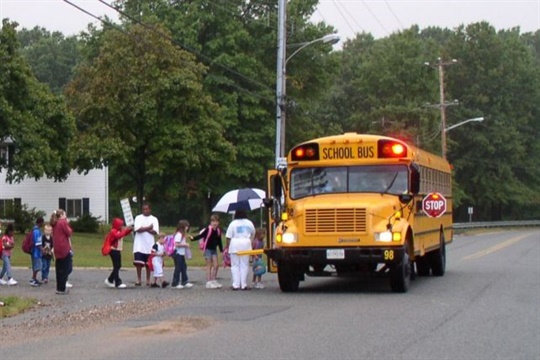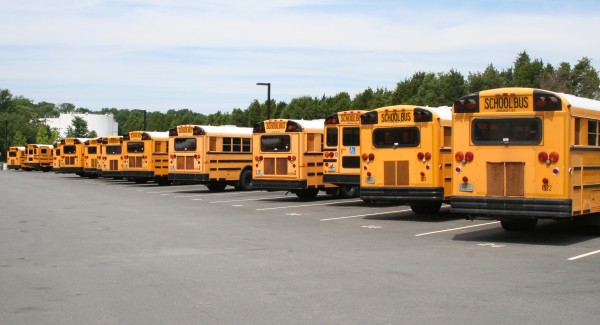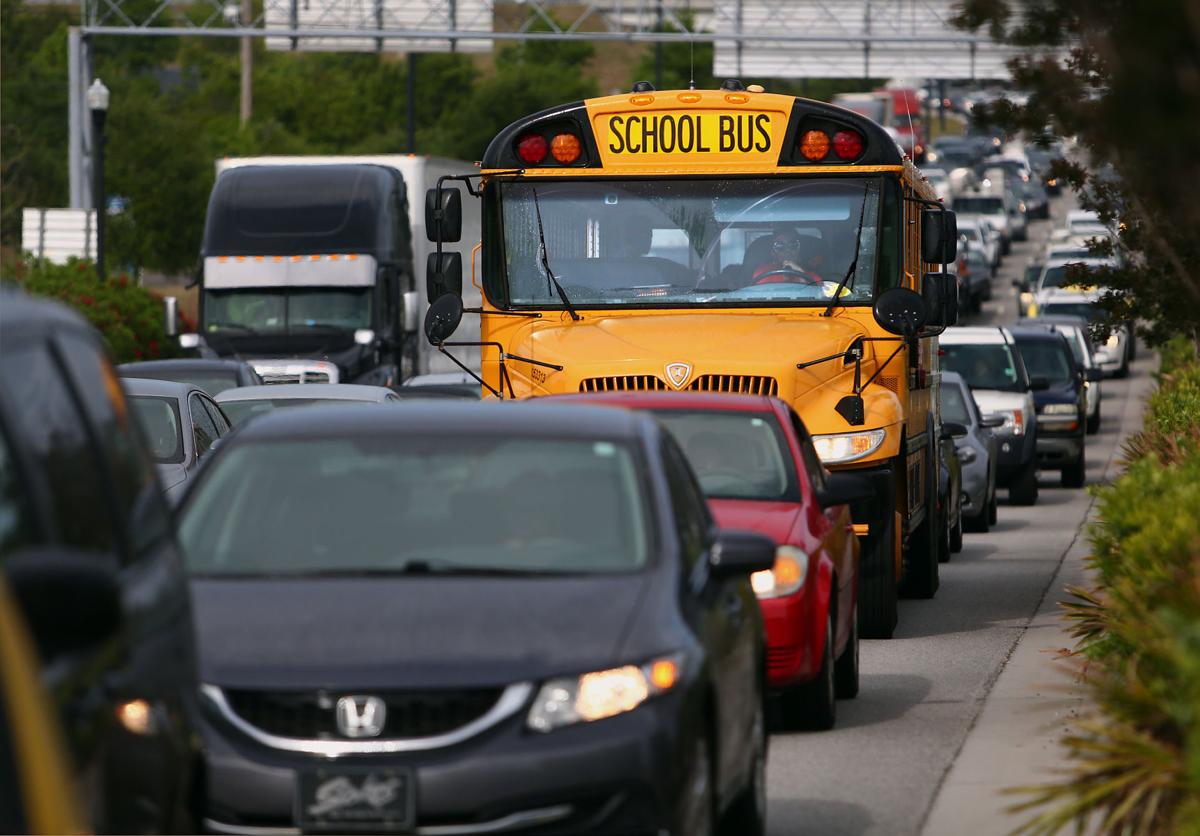Traffic congestion at school zones is a safety concern for all due to queuing up of vehicles and poor visibility ahead. It inconveniences parents, students, school authorities, school bus drivers, police, and the residential neighborhood. The number of school-going students being driven to school by private cars has risen considerably in urban areas. The growth in the use of cars by parents to drop off and pick up students sees fewer children walking or biking to school. Unanticipated traffic and a large number of students at the school gates at a time render all arrangements made by schools ineffective to control traffic congestion.
 Pick up and drop off points have to be designated for cars and buses. A dedicated drop off zone away from the parking area will help in improving traffic flow. The use of alternate routes in and out of school has to be encouraged so that all vehicles do not congregate in one location. School volunteers or staff can escort children from car to school. This will quicken the drop-off process.
Pick up and drop off points have to be designated for cars and buses. A dedicated drop off zone away from the parking area will help in improving traffic flow. The use of alternate routes in and out of school has to be encouraged so that all vehicles do not congregate in one location. School volunteers or staff can escort children from car to school. This will quicken the drop-off process.
 Temporary parking spaces for pick-up and drop-off can be created by using sign-boards for peak hours only. Parking spaces near schools in urban areas can be very limited. Unless the school has a dedicated parking area it is extremely difficult to get parking slots near the school. City councils and district councils may be approached for additional space which might infringe into neighboring areas. Consent of neighbors is essential and hence a plan can be negotiated with them for utilizing the space only during school hours after which it will remain vacant for their use. High school children driving to school have to be given clear instructions and lessons on how to park in the areas assigned to them. 5. Traffic Conditions
Temporary parking spaces for pick-up and drop-off can be created by using sign-boards for peak hours only. Parking spaces near schools in urban areas can be very limited. Unless the school has a dedicated parking area it is extremely difficult to get parking slots near the school. City councils and district councils may be approached for additional space which might infringe into neighboring areas. Consent of neighbors is essential and hence a plan can be negotiated with them for utilizing the space only during school hours after which it will remain vacant for their use. High school children driving to school have to be given clear instructions and lessons on how to park in the areas assigned to them. 5. Traffic Conditions  The timings of traffic lights in the area can be revised if necessary to suit the school period. This requires coordination with the local traffic authorities and the adjacent residential areas. Re-routing of streets will force drivers to seek alternative routes. ‘No entry’ or ‘One-way’ signs on roads leading to the school can divert traffic away from the school. Road humps can be installed to reduce the speed of vehicles.
Increased police patrolling during peak hours can be of help. Double parking, waiting in no parking zones, parking across driveways and parking too close to pedestrian crossings can be curtailed with patrolling. Doubling of traffic fines for parking offenses and speeding in the school zones are deterrents and reduce congestion. 6. School Timings Start and finish timings for elementary, middle and high school students can be staggered. Though it might prove inconvenient for parents who have children in all sections, the staggering of school timings can reduce traffic to a large extent.
The timings of traffic lights in the area can be revised if necessary to suit the school period. This requires coordination with the local traffic authorities and the adjacent residential areas. Re-routing of streets will force drivers to seek alternative routes. ‘No entry’ or ‘One-way’ signs on roads leading to the school can divert traffic away from the school. Road humps can be installed to reduce the speed of vehicles.
Increased police patrolling during peak hours can be of help. Double parking, waiting in no parking zones, parking across driveways and parking too close to pedestrian crossings can be curtailed with patrolling. Doubling of traffic fines for parking offenses and speeding in the school zones are deterrents and reduce congestion. 6. School Timings Start and finish timings for elementary, middle and high school students can be staggered. Though it might prove inconvenient for parents who have children in all sections, the staggering of school timings can reduce traffic to a large extent.
Steps to Reducing School Zone Traffic Congestion
Vehicle congestion at school entrances conflicts with pedestrians and cyclists coming to school. They may not have access to sidewalks. School parking areas may be unorganized. School buses may block the visibility of pedestrians and cyclists. Parents and motorists may display unruly behavior parking in no-zone areas, double parking, speeding or ignoring traffic restrictions. A study on the movement of the traffic in and around the school would be the first step before rules for traffic reduction are set in place. Knowing the type of roads around, availability of parking spaces, type of vehicles – vans, buses, cars- that use the road, pedestrian safe ways are a necessity to drawing up traffic plans. 1. Education on Alternative Means of Transport: One of the best ways to ease school zone traffic congestion is to reduce the number of vehicles that converge at school gates during opening and closing times. Parents state traffic hazards, time constraints, distance, and bad weather as reasons for transporting their children to school. Parents have to be educated about the alternate modes of transport their child can avail of. They have to be appraised of the role they have in reducing school zone traffic congestion and increasing student safety. This information can be provided through leaflets or PTA newsletters. Parents and students have to be educated on the benefits of walking or cycling to school. The health aspect and the impact on the environment are to be incorporated into the curriculum so that students understand the concept and are encouraged to walk. The school can reward them with a point system. Students can join walking school bus programs where an adult escorts a group of children along a pre-determined route to school. Children living within walking distance of the school can avail of this method which keeps pedestrian safety in mind. The school bus is the best option for students who live further away from school. Studies show that an approximate number of 38 cars are required to transport an average busload of 45 children. Availing school bus services can reduce traffic congestion at school access points as well as on the roads. Car-pooling is another option for students living in close-by locations. 2. Access points The number of entry and exit points in school has to be regulated. Larger the number of these points, greater will be the congestion. Situating these entrances and exits around the school where the road is bigger or accessibility to parking spaces is nearer will reduce the congestion.Also Read: Top 18 Road Safety Rules to Teach your Students
Students walking or cycling to school have to be provided with separate entrances and exits. This will reduce the risk of accidents and traffic hold-ups around the school. Students should not be allowed to ride their cycles within the school premises. All-access points have to be locked during school hours and opened only when students have to be let in and out. Security guards have to be stationed at all access points. 3. Pick up and Drop off points Pick up and drop off points have to be designated for cars and buses. A dedicated drop off zone away from the parking area will help in improving traffic flow. The use of alternate routes in and out of school has to be encouraged so that all vehicles do not congregate in one location. School volunteers or staff can escort children from car to school. This will quicken the drop-off process.
Pick up and drop off points have to be designated for cars and buses. A dedicated drop off zone away from the parking area will help in improving traffic flow. The use of alternate routes in and out of school has to be encouraged so that all vehicles do not congregate in one location. School volunteers or staff can escort children from car to school. This will quicken the drop-off process.
Read Also: Top 10 School Bus Companies
Directing different types of traffic to different locations around the school can help reduction in congestion. Bus pick-up and drop-off are assigned to one area while parents pick and drop in another area. Staff can be provided parking on a different side. 4. Parking Temporary parking spaces for pick-up and drop-off can be created by using sign-boards for peak hours only. Parking spaces near schools in urban areas can be very limited. Unless the school has a dedicated parking area it is extremely difficult to get parking slots near the school. City councils and district councils may be approached for additional space which might infringe into neighboring areas. Consent of neighbors is essential and hence a plan can be negotiated with them for utilizing the space only during school hours after which it will remain vacant for their use. High school children driving to school have to be given clear instructions and lessons on how to park in the areas assigned to them. 5. Traffic Conditions
Temporary parking spaces for pick-up and drop-off can be created by using sign-boards for peak hours only. Parking spaces near schools in urban areas can be very limited. Unless the school has a dedicated parking area it is extremely difficult to get parking slots near the school. City councils and district councils may be approached for additional space which might infringe into neighboring areas. Consent of neighbors is essential and hence a plan can be negotiated with them for utilizing the space only during school hours after which it will remain vacant for their use. High school children driving to school have to be given clear instructions and lessons on how to park in the areas assigned to them. 5. Traffic Conditions  The timings of traffic lights in the area can be revised if necessary to suit the school period. This requires coordination with the local traffic authorities and the adjacent residential areas. Re-routing of streets will force drivers to seek alternative routes. ‘No entry’ or ‘One-way’ signs on roads leading to the school can divert traffic away from the school. Road humps can be installed to reduce the speed of vehicles.
Increased police patrolling during peak hours can be of help. Double parking, waiting in no parking zones, parking across driveways and parking too close to pedestrian crossings can be curtailed with patrolling. Doubling of traffic fines for parking offenses and speeding in the school zones are deterrents and reduce congestion. 6. School Timings Start and finish timings for elementary, middle and high school students can be staggered. Though it might prove inconvenient for parents who have children in all sections, the staggering of school timings can reduce traffic to a large extent.
The timings of traffic lights in the area can be revised if necessary to suit the school period. This requires coordination with the local traffic authorities and the adjacent residential areas. Re-routing of streets will force drivers to seek alternative routes. ‘No entry’ or ‘One-way’ signs on roads leading to the school can divert traffic away from the school. Road humps can be installed to reduce the speed of vehicles.
Increased police patrolling during peak hours can be of help. Double parking, waiting in no parking zones, parking across driveways and parking too close to pedestrian crossings can be curtailed with patrolling. Doubling of traffic fines for parking offenses and speeding in the school zones are deterrents and reduce congestion. 6. School Timings Start and finish timings for elementary, middle and high school students can be staggered. Though it might prove inconvenient for parents who have children in all sections, the staggering of school timings can reduce traffic to a large extent.
Read Also: Buying a School Bus – 10 Important Points You Should Know
There is no single solution to traffic management to avoid congestions at schools. Traffic issues differ for each school depending on their size and location. Though the general guidelines can be followed each issue has to be analyzed and dealt with accordingly.

















